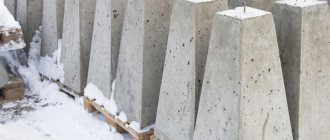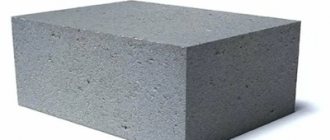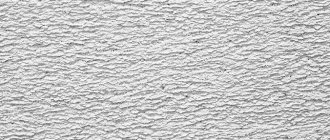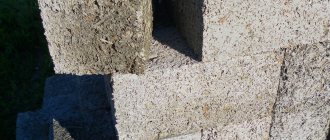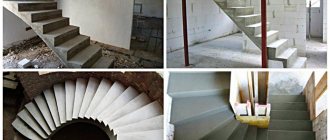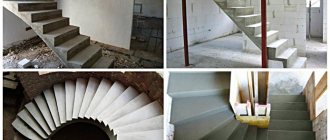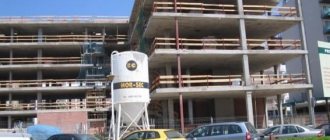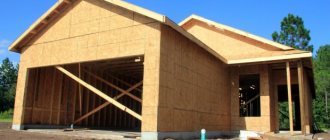In the construction of fencing structures, concrete blocks for fences will be an excellent alternative to brick. Moreover, the technology for laying pillars and sections is similar, and the process itself takes much less time. The construction of this material copes well with decorative and protective functions. Following the recommendations of the masters, you can build such a fence with your own hands.
Important information:
- Distance from house to neighbor's fence SNiP
- What trees to plant behind the fence
Composition, manufacturing technology
The basis of the products is pure concrete or slag concrete, sand. The remaining components are auxiliary and are added depending on the production method. These include:
- crushed stone;
- medium or fine gravel;
- broken bricks, pieces of concrete;
- expanded clay;
- stone chips;
- broken glass;
- slag.
Broken glass is added to the mixture only for decorative purposes, so that the surface shines in different colors.
They produce solid and hollow blocks.
Solid ones are practically not used for fence structures, since they put a large load on the foundation and have a high price.
The generally accepted material for fencing is hollow blocks. Light in weight. They are inexpensive. The holes inside the product allow you to conveniently hide electrical, intercom, and alarm cables inside.
To strengthen the structure, the masonry is reinforced, and in the support version, it is placed on top of a metal pillar. Many of them have special grooves, which simplifies installation, which is why another name for blocks is typesetting.
The finished material is obtained in two ways:
- Vibration casting. Forms are installed on a special vibrating table into which liquid concrete solution is poured. The mixture is compacted due to vibration. The block has a smooth surface. The choice of colors is large, but durability and frost resistance are low.
- Vibrocompression. Achieved using semi-dry concrete technology - the ingredients are mixed with a small amount of water. The compaction of the solution is carried out both in the horizontal direction - the platform vibrates, and in the vertical direction - the press works. The surface is rough. The choice of shades is small, but the blocks are highly durable and resistant to temperature changes.
To build a durable fence, it is better to use vibration-pressed blocks, although they will cost more.
Combination
Kermazi concrete is an excellent solution for the construction of a combined fence. You can lay out 5 rows of blocks, create columns, and then use corrugated sheets, forged structures, or other fencing. There are many options for filling the fence.
Remember that if you decide to install a combined fence, then before moving to another material, lay the final row with the holes down. It is important that the surface is flat, without depressions. Then install the partition blocks in approximately two rows.
Upon completion of installation work, the columns should be closed with special covers made of plastic or metal. If you prefer a solid fence, then cover the walls with parapets and finials. This will protect the masonry from bad weather and give the structure a pleasant appearance.
Advantages and disadvantages of the material
Photo: size guide and types of blocks
Among the advantages:
- Service life – up to 100 years.
- Good noise insulation and dust protection - such a fence can be installed near highways.
- Fire resistance. The material becomes an obstacle to the spread of the fire.
- Protecting the yard from prying eyes.
- Choice of colors, shapes, textures. Imitations of stone, wood, and sandstone are popular.
- Quick assembly. Laying sections takes less time than with brick laying.
- Resistance to mechanical damage.
- Affordable prices. Construction of a fence from pre-fabricated blocks will be much cheaper than from natural stone or brick.
There are not many disadvantages to the material:
- The impressive weight requires the construction of a solid foundation (strip), which entails extra expenses.
- The masonry process is labor-intensive.
- If you want a fence using an unusual masonry technique, you will have to contact a specialist.
But when the fence is built for years, these shortcomings are not so significant.
Creating forms yourself
However, a person himself is capable of making similar forms. To speed up the process, you will need a multi-position matrix. With its help, you can cast four pillars at a time.
The matrix will require boards with the following parameters:
- 3x 25 x 250 cm (9 pieces);
- 3x 25 x 100 cm (2 pieces).
You will also need the following from the list:
- wood screws,
- a tool for screwing them in (a screwdriver, but a screwdriver is better),
- metal plates (8 pieces),
- sheets of tin,
- used oil,
- concrete composition,
- fittings
The following is a diagram of such a matrix:
The action plan is:
- Six boards 250 cm long and three boards 100 cm long are covered with tin on one side. The three remaining boards are upholstered on both sides.
- The formwork is assembled using screws. Nails are not suitable here, because they are very difficult to remove.
- The matrix is treated with waste oil.
- The reinforcement is tied and laid.
- The concrete composition is poured. He meticulously equalizes the entire form.
- An equal distance is measured on both sides, and metal plates are installed. The frame will be attached to them.
- The matrix is covered with damp burlap. This mold must be wetted for seven days.
Types of typesetting blocks and their characteristics
The average weight of one block is from 10 to 25 kg. Length 30–50 cm, width 15–25 cm, height 14–25 mm.
Due to these dimensions, the block is often 3 times larger than a brick, which significantly speeds up the laying.
Based on their composition and technical characteristics, they are divided into several types. Let's look at each of them in more detail.
Expanded clay concrete
Expanded clay is called clay that is fired at high temperatures. Thanks to the addition of expanded clay, the weight of the concrete block is reduced.
Photo: To protect expanded clay concrete blocks from moisture, facade paint and polymer compounds (water repellents) are used. To apply paint, use a spray gun.
The choice of colors and textures is small. The surface is often rough. The shape is rectangular.
Decorative
Raw materials - clay, artificial stone, concrete and various fillers.
According to the design features there are:
- with grooves;
- without grooves;
- embossed;
- smooth.
A decorative block for a fence is often taken in dimensions of 39*14*18.8 cm. Standard and gable pillar covers are made from the same material.
They also produce decorative slabs for fencing, which allows you to quickly assemble modular structures that do not require finishing.
Photo: color scheme of blocks
The surface of such blocks can imitate:
- slate;
- brick;
- tree;
- tiles;
- sandstone.
They are similar in structure and size to gas blocks and foam blocks. The price is affordable. Wide choice of colors.
Thanks to their original appearance and light weight, they have gained popularity not only in the assembly of fences, but also in the construction of houses and gazebos.
Construction
The raw material is pure concrete. They have impressive weight. There are cavities inside. The surface is smooth on top. Color – grey. Due to their unattractive appearance, they are rarely used when constructing fences in the private sector, more often as post material, or for fences at industrial sites.
Cinder blocks
The filler is slag.
Photo: stone obtained by vibration pressing - cinder block.
Important advantages of this additive are the ability to retain heat and different shades. The last factor allows you to obtain colored material without adding dyes.
They are light in weight. Frost-resistant. There are cavities inside.
Concrete
Another name is besser. Depending on the manufacturer, crushed stone, gravel, and screenings are added to the composition. These components strengthen the structure of the blocks, increase strength, and resistance to mechanical damage. Color – gray with shades. They are inexpensive.
Photo: building hollow concrete block
Foam blocks
The composition may be different for each manufacturer.
The production is based on the technology of foaming components.
Popular types are gas silicate and aerated concrete.
The structure can be solid or hollow.
When constructing fence posts, foam blocks are often used. This is due to its low weight and convenient size.
Photo: after installing the fence, care should be taken to protect it from moisture and precipitation. One way is hydrophobic impregnation
Dimensions of the standard block – 20*20*40 cm.
Often they take material whose surface imitates torn stone.
Finished sections and pillars made from blocks can be painted. You can learn more about the procedure and application nuances here: “Painting a concrete fence.”
Splitter
This is a hollow material consisting of two halves.
Photo: hollow blocks without a bottom are made in different colors
During construction, the voids of splitter products are reinforced and filled with concrete mortar, and the blocks become permanent formwork.
More about plastic
One of the materials used in the manufacture of fence forms is worth special attention - this is plastic.
Advantages
When we talk about plastic, we mean the following invaluable advantages:
Greater strength is thanks to modern production technologies, although initially, it was precisely problems with strength that did not allow plastic to enter the wide “construction” road.
Cheapness. Where there is plastic, there is casting, which means ready-made and mass-produced technologies
This is especially important for the production of fences. when the forms for fence posts and the spans between them already form a single whole, which directly comes out of the press in production.
The shapes of the fences seem to be specially made for use on industrial sites, where the speed of construction comes to the fore, although the design side of the matter is not forgotten
- Ease. which does not at all contradict reliability. But the installation speed increases by an order of magnitude.
- Extreme resistance to negative environmental influences. This feature of modern plastic has been tested in pipes and does not need any proof.
- Huge selection of design solutions. This is also the merit of the very process of producing plastic structures - casting, which is accompanied by the addition of all kinds of additives and dyes, creating an incredible range of colors at the output.
Disadvantages of plastic
Strictly speaking, plastic fence structures have no disadvantages.
More precisely, their advantages are also a continuation of their disadvantages (although, rather, on the contrary).
Ease. But, firstly, plastic is often framed in a rigid metal case, and, secondly, the concept of lightness is very relative for a panel measuring 3 by 2 meters with a thickness of up to 15 cm.
Molds for the production of fences can include all the elements in a single design - then only 2 problems remain to be solved: dimensions and installation
Insufficient reliability. Again, given post structures, any material requires very secure installation of fence posts. The reliability of the entire structure primarily depends on them. But, in addition, no matter what the fence is, it will not withstand the braking of buses on it.
When installing fences in the photo, you cannot do without such a guide as installation instructions; all elements here must be very precisely adjusted to each other
Helpful advice! Installing any fence requires careful attention to post drainage. Keep in mind that the hole for the post should be made 30-40 cm below the freezing level of the soil. If your soil is prone to collecting moisture, so-called heaving, then the best option would be to remove it completely and install the post in a pre-filled mixture of sand and fine gravel. Do not forget to compact this manually prepared soil thoroughly. Drainage must also be carried out at ground level, at a distance of 20-30 cm from the pillar and to a depth of at least 15 cm.
You can even construct a fence from pre-prepared forms. You just need to carefully familiarize yourself with all the options available to you, evaluate all the disadvantages and advantages of each. Be sure to coordinate all proposals with the nature of the soil under your future fence. Most likely, you will entrust the installation of the fence to already experienced craftsmen, but be aware of all the decisions made, then you will not have to regret the choice you made.
It is not necessary that the shape of the fence post must exactly match the shape of its span, the main thing is just to maintain a single style
In the video presented in this article you will find additional information on this topic.
Famous manufacturers
The following companies have proven themselves well:
- Eurovason. Enterprise in St. Petersburg. The blocks are produced using the “washed concrete” technology. Granite crumbs and pebbles are added to the mixture. Thanks to this, the blocks become very similar to natural stone, both in appearance and in properties.
- "4th Bastion". The company is also from St. Petersburg. Began its activities in 2001. Produces concrete blocks, pillar covers in a choice of textures and colors. Delivers goods throughout Russia.
- "ConstantFence". Part of the group. Began work in 2009. Engaged in the manufacture of fences of varying complexity and designs, including those made from concrete blocks. The warranty on all products is 5 years.
- "SMIC HOUSE". Located in Moscow. Produces construction materials. Delivers to all regions of the country. Product warranty – 3 years.
Each company accepts individual orders for production and also installs turnkey fences.
Monolithic pillars
Making monolithic concrete supports is a simple process. This is an opportunity to create a high-quality base for a fence yourself at minimal cost. The great advantage of a monolithic pillar is the ability to decorate it at your own discretion. The supports can be made of any shape - round, rectangular or square, the main thing is to assemble the appropriate formwork. To create the correct shapes, boards or plywood are suitable; for round supports, a plastic pipe sawn in half.
Installation of a monolithic concrete pillar
- A hole is dug and crushed stone is poured onto the bottom.
- A reinforcement frame welded from longitudinal and transverse rods is installed in the hole. The verticality of the frame is checked by the building level.
- Concrete is poured into the hole and compacted.
The hole is left to harden. Reinforcement of a hole for pouring concrete into a pillar - The formwork is being installed. The reinforcement cage should not come into contact with the formwork, but should be located exactly in the middle.
- The formwork is filled in layers with a cement composition, each layer is bayoneted so that there are no air cavities left. After 3 days, the formwork is removed.
The resulting nondescript concrete pillar will be given a decorative touch by textured plaster, artificial stone or decorative brick.
Decorative stone for fence posts
Artificial stone is widely used for both interior and exterior decoration of buildings, foundations, finishing and cladding of fences and pillars. It is a composition of cement, sand and various additives and coloring pigments. Decorative stone perfectly conveys the texture and beauty of natural minerals and at the same time has a number of additional advantages that distinguish it from natural materials:
Fence trimmed with decorative stone
- Price. Natural stone has a high cost compared to artificial material cast from concrete.
- Ease. Decorative stone has less weight, it is easier to lay it on regular tile adhesive or cement without additional fastening. In addition, the lightweight material does not overload the supports.
- Correct form. Thanks to its straight lines and geometry, artificial stone does not require complex fitting and selection of elements.
- Resistance to negative natural factors. The facing stone is suitable for external work; it is not afraid of moisture, critical temperatures and exposure to ultraviolet radiation.
- Variety of choice. The shape, color and texture of the artificial material can be any.
The principle of installing a fence made of concrete blocks
The sequence of work is the same as for the construction of massive fences made of other materials. But there are still some nuances at each stage of masonry. Let's take a closer look at the features of self-construction.
Zero cycle
It consists of choosing a location, preparing the area for marking (cleaning up debris, getting rid of vegetation). The marking is carried out according to the developed scheme. If difficulties arise during calculations, then a construction calculator comes into play.
Along the perimeter of the future fence, in the places where the posts are installed, pegs are driven in and a rope is stretched between them. The installation area for gates and wickets is marked. After which the depth of the supports and the entire foundation is determined.
The best option for arranging the base is 20–30 cm below the soil freezing level.
Choosing the type of foundation
Since the structure will create an impressive load, it is better to choose one of the types of strip base. If the fence will stand on stable soil, then a monolith will do. But it should be taken into account that the width of the trench is made greater than the size of the block, so that there is also room for formwork.
The procedure for filling the tape is as follows:
- They dig a trench. The bottom is compacted.
- Create a drainage layer of sand and crushed stone 20 cm, 10 cm each, water it with water, and compact it.
- Waterproofing is carried out: the bottom and walls of the trench are lined with roofing felt.
- Formwork made of wooden boards is knocked down along the perimeter.
- A frame is knitted or welded from pieces of reinforcement and wire. Its dimensions should be 3–5 cm less than the width of the trench.
- Leave reinforcement outlets of 15–20 cm for installing the bottom row of blocks.
- The pillars can be reinforced using metal pipe fasteners in the center or wire rods can be extended to the entire height of the support.
- Mix the solution. You should take cement of a grade not lower than M200. The ratio is 5:1:3, where for 5 parts of crushed stone there is one part of cement and three parts of sand plus water.
- It is better to secure spacers around the formwork so that the concrete mixture does not deform the foundation.
- The trench is filled with concrete mixture.
- After a week, you can remove the formwork.
- The top is wrapped in roofing felt and lubricated with bitumen.
About the construction of other strip foundations.
Installation and laying of pillars
For supports, it is worth taking a pipe of at least 6 cm in diameter, and for installation in places where gates and gates are fastened - larger.
Decorative blocks are simply strung on top of pipes or reinforcement bars. Once 3-4 blocks are fixed, concrete is poured into the cavity, compacted and air is released. The following elements are laid according to the same pattern.
All work is carried out using a building level.
Users often search for:
- Fence made of concrete panels
- Types of brick fences
Causes of destruction
Sketch of the correct design of the structure
Often we can see destroyed fences that seemed to have such a strong structure. The whole trouble most often begins with the supporting elements. The supporting part of the fence can collapse for several reasons:
- non-compliance with installation rules, for example, small depth;
- the design of the support element pit does not correspond to the characteristics of the soil;
- the use of low-quality material in the manufacture of a product or in the construction of a foundation.
All such shortcomings will reveal themselves after the first wintering of the structure, so you shouldn’t take risks. It is better to consult with specialists, play it safe several times, than later be disappointed in the fencing structure and regret the money wasted.
Well, if all the work was done efficiently, in compliance with all standards and rules, then such a fencing structure will last for decades, especially if it is provided with decent care.
Application
The spread of the trend with decorative pillars began several centuries ago, and in order to get a rough idea of architectural traditions, just look at the design of palaces in St. Petersburg or Paris.
The classic combination of metal and stone has been borrowed by modern builders for fencing government buildings and luxury mansions.
Installation at the dacha
The modern construction industry, which has mastered dozens of new materials, has expanded the concept of decorative fence posts. Brick and natural stone remain the classic option for any type of fence.
But concrete, mesh structures with crushed stone, and plastic appeared, which decorate the most primitive options. There are multiple price lists with numerous examples that give an idea of what decorative blocks for fence posts are.
Variety of options
The use of pillars has expanded the scope of demand, but has not limited it, and on modern construction sites you can find many unconventional options for using decorative pillars - from an enclosed atrium and veranda to a large balcony, observation deck, canopy in front of the house, equipped for decorative purposes.
The differentiation of the scope of use of pillars, pillars and columns has led to the need for a targeted choice made taking into account all components.
Fence of a private house
The criteria for selecting the necessary style components were:
- design options and methods of its installation, construction and stability;
- manufacturing material, in which there are possibilities for stylization, replacing natural decorative stone with no less expressive fakes made of plastic;
- durable frame devices, giving the chance to use lighter and cheaper raw materials without loss of visualization and strength;
- dimensions, parameters and configurations to create a unique or standard constant of the same familiar brick fence;
- additional decorative elements (balls and cones, lamps, combinations with metal elements, stucco or its imitation);
- color scheme (contrasting, similar in color perception and tone, combined, imitating geometric or abstract patterns);
- modification of shape (parallelograms, rounded outlines, cones, columns with pedestals or pedestals).
Storage of finished racks
